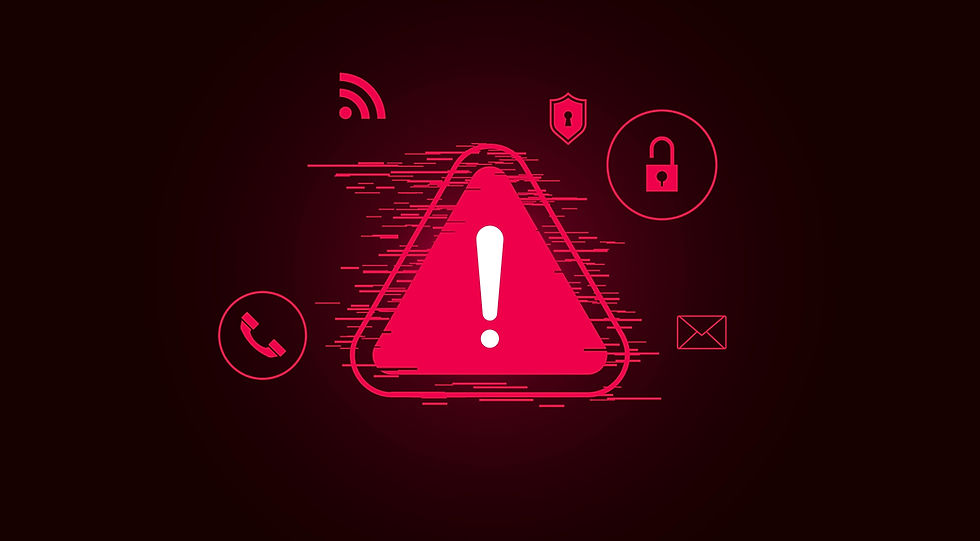Real-Time Threat Monitoring: How EDR Enhances Incident Response Capabilities
- Joel Proulx
- Apr 30, 2024
- 4 min read
Updated: Feb 12

The headlines are filled with them: massive data breaches, ransomware attacks crippling businesses. Cybercrime is a multi-billion dollar industry, and businesses of all sizes are targets. Traditional security measures simply can't keep up. Enter Endpoint Detection and Response (EDR) – a powerful tool to combat this ever-growing threat.
The EDR Advantage: Proactive Protection in a Reactive World
Traditional antivirus software relies on pre-defined signatures to identify threats. But cybercriminals are constantly evolving their tactics, developing new malware and exploiting unknown vulnerabilities.
EDR solutions take a different approach. By continuously monitoring endpoint activity, analyzing system behavior and suspicious actions, even the most sophisticated threats to be detected.
EDR offers a comprehensive approach to increase endpoint visibility, providing numerous benefits:
EDR goes beyond signature-based detection, identifying anomalies and suspicious behaviors that might indicate a potential attack.
Real-time monitoring allows EDR to detect threats in their early stages, enabling a faster and more effective response.
EDR provides the tools and insights needed to investigate incidents quickly and efficiently, minimizing damage.
Gain complete endpoint visibility, allowing you to identify vulnerabilities and track user behavior.
EDR facilitates proactive threat hunting, enabling security teams to uncover hidden threats before they cause damage.
In the event of a breach, EDR provides detailed logs for forensic analysis, helping to understand the scope of the attack and identify the root cause.
Important Factors to Consider
While endpoint security offers significant advantages, successful implementation requires careful consideration of several factors. Choose a solution that aligns with your specific needs and infrastructure. Consider factors like scalability, ease of use, and integration with existing security tools.
1. Selecting the Right Partner
Choosing the right EDR solution is crucial for maximizing its effectiveness. Here are some key factors to consider:
Evaluate your organization's size, industry, and security posture. Consider the types of devices you need to protect (laptops, desktops, servers, mobile) and how the EDR solution integrates with existing security tools.
Look for an EDR solution that offers a combination of signature-based detection, behavioral analysis, and machine learning to identify a wide range of threats.
Choose a solution that scales to accommodate your current and future needs. Consider the complexity of deployment and ongoing management.
A user-friendly interface with clear dashboards and reporting is essential for your security team to efficiently monitor and investigate threats.
Look for an EDR solution that integrates with threat intelligence feeds to stay updated on the latest cyber threats and vulnerabilities.
EDR solutions come with varying price points. Evaluate the features and value proposition against your budget.
Remember: Don't be afraid to leverage free trials or demos to test different EDR solutions before making a final decision.
2. Configuring Policies and Alerts
EDR solutions generate a wealth of data. To avoid information overload and ensure you capture critical events, effective policy and alert configuration is essential. Establish a baseline for normal endpoint activity within your organization. This helps identify deviations that might indicate suspicious behavior. You’ll also want to configure alerts based on severity and risk level. Focus on high-priority alerts that require immediate attention. Take care to fine-tune your EDR policies to minimize false positives and consider configuring automated actions for specific threats.
3. Training and Education
Your employees are a critical line of defense against cyber threats. Investing in training and education empowers them to identify suspicious activity and report it.
Conducting regular phishing simulations, educating employees on common threats and social engineering tactics and training your security team on your chosen EDR solution are all security best practices.
4. Continuous Monitoring and Analysis
EDR is most effective when used proactively. To maximize the effectiveness of your EDR solution, implement continuous monitoring practices like routine review of EDR dashboards and alerts, proactive threat hunting through endpoint data analysis, a defined incident response plan for handling security breaches, SIEM integration for a comprehensive view of security events, and regular vulnerability assessments with prompt patching to minimize potential attack surfaces.
PremCom: EDR solutions designed for you
PremCom offers EDR solutions designed to simplify real-time threat monitoring and enhance your incident response capabilities. Acting as a vigilant security guard for your endpoints- devices like laptops, desktops, servers, and even mobile phones. Here’s a breakdown of the key functionalities:
Going beyond mere detection, it delves deeper, analyzing endpoint activity for suspicious behavior and taking action to contain or remediate threats. This can involve isolating infected devices, terminating malicious processes, or even rolling back changes.
Keeps a watchful eye on your endpoints 24/7, constantly gathering data on system activity. This allows for immediate identification of anomalies and potential threats.
Empowers you to proactively search for hidden threats within your network and extract actionable insights from endpoint data.
Shortens the time it takes to identify and respond to security incidents. With real-time threat detection and automated remediation options, EDR helps minimize damage and swiftly restore normalcy.
EDR doesn’t work in isolation. It connects the dots by correlating events from various endpoints, providing a holistic view of potential threats across your network. This broader perspective helps security teams identify complex attacks that might involve multiple devices.
Utilizes advanced analytics and machine learning (ML) to identify subtle behavioral patterns that might indicate a lurking threat. This proactive approach helps stay ahead of even the most sophisticated attacks.
Machine learning plays a crucial role in EDR solutions leveraging ML algorithms to analyze vast amounts of data and identify even the most obscure threats. Additionally, ML can automate some remediation tasks, freeing up security analysts to focus on more complex issues.
EDR is a powerful tool that can significantly enhance your organization’s cybersecurity posture. By offering real-time monitoring, advanced threat hunting, and rapid incident response, EDR empowers you to take control of your network security and keep your data safe. In today’s threat landscape, EDR is no longer a luxury, it’s a necessity.



